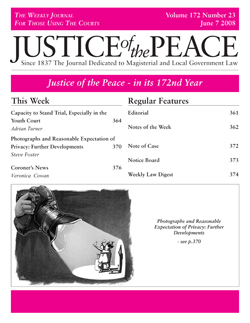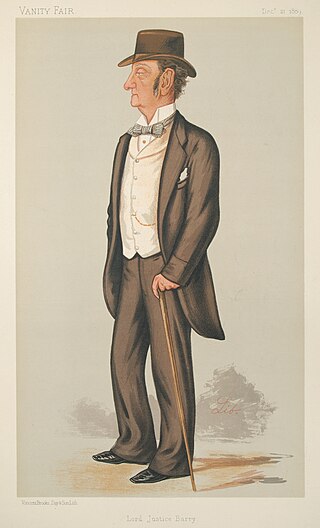Related Research Articles

John Venn, FRS, FSA was an English mathematician, logician and philosopher noted for introducing Venn diagrams, which are used in logic, set theory, probability, statistics, and computer science. In 1866, Venn published The Logic of Chance, a groundbreaking book which espoused the frequency theory of probability, arguing that probability should be determined by how often something is forecast to occur as opposed to "educated" assumptions. Venn then further developed George Boole's theories in the 1881 work Symbolic Logic, where he highlighted what would become known as Venn diagrams.
Nominate reports, also known as nominative reports, named reports and private reports, is a legal term from common-law jurisdictions referring to the various published collections of reports of English cases in various courts from the Middle Ages to the 1860s, when law reporting was officially taken over by the Incorporated Council of Law Reporting, for example Edmund F. Moore's Reports of Cases Heard and Determined by the Judicial Committee and the Lords of His Majesty's most Honourable Privy Council on Appeal from the Supreme and Sudder Dewanny Courts in the East Indies published in London from 1837 to 1873, referred to as Moore's Indian Appeals and cited for example as: Moofti Mohummud Ubdoollah v. Baboo Mootechund 1 M.I.A. 383.

The Criminal Law & Justice Weekly (CL&J), formerly known as Justice of the Peace (JPN) is the oldest legal weekly magazine in England and Wales. It has continuously reported all aspects of the law for the magisterial and criminal courts, since first published in 1837.

Charles Robert Barry QC, PC was an Irish politician and lawyer who rose to become a Lord Justice of Appeal for Ireland.

Stone Buildings, Lincoln's Inn were constructed from 1774 to 1780. The architect was Sir Robert Taylor. Stone Buildings is a Grade I listed building. Stone Buildings appear in Anthony Trollope's novel The Prime Minister.
Solicitors Journal is a legal journal published in the United Kingdom.
Anthony Hammond (1758–1838) was an English barrister and legal writer, known as a legal reformer. His reform proposals for legal codification, influenced by Jeremy Bentham but also by Robert Malthus, went further than was acceptable at the time.
Richard Bligh (1780-1838), chancery barrister, son of John Bligh and a cousin of Admiral William Bligh, was educated at Westminster School and Trinity College, Cambridge. He graduated B.A. in 1803 and M.A. in 1806. He was called to the bar by the Society of the Inner Temple on 1 May 1807 and was admitted to the Society of Lincoln's Inn on 17 November 1826. He became an equity draftsman at the chancery bar. He was a hard worker, and had a fair amount of practice in his profession; but a considerable amount of his time was taken up by reporting in the House of Lords, in which business he was engaged for several years.
Sir Percy Henry Winfield was Rouse Ball Professor of English Law between 1928 and 1943. He was born at Stoke Ferry in Norfolk. He died at his home at 13 Cranmer Road in Cambridge. He was married to Lady Helena Winfield, née Scruby. He was a fellow of St John's College, Cambridge.
Current Law Statutes Annotated, published between 1994 and 2004 as Current Law Statutes, contains annotated copies of Acts of the Parliament of the United Kingdom passed since 1947 and Acts of the Scottish Parliament passed since 1999. It is published by Sweet & Maxwell in London and by W Green in Edinburgh. It was formerly also published by Stevens & sons in London.
Stone's Justices' Manual is a book published by LexisNexis Butterworths. It is "the standard work on summary procedure". It displaced Burn's Justices of the Peace as the standard work on that subject from 1850 onwards. By 1914, it was old, well-established and formidably large.
Charles Sprengel Greaves MA QC (1802–1881), eldest son of William Greaves MD (1771–1848) of Mayfield, Staffordshire, by his first wife, Anne-Lydia, was born at Burton on 18 July 1802. He entered Rugby School on 18 July 1816 and matriculated at Queen's College, Oxford on 27 February 1819, graduating BA on 25 November 1823 and MA on 13 April 1825. Greaves was called to the bar by the Society of Lincoln's Inn on 22 November 1827, entered the Inner Temple ad eundem in 1828, and attended the Oxford Circuit and Gloucester Sessions. He became Queen's counsel on 28 February 1850, but by then he had for many years ceased to practise. He became a bencher of Lincoln's Inn on 15 April 1850. He was a magistrate and deputy lieutenant for Staffordshire, and also a magistrate for the county of Derby. He was the draftsman of the Criminal Procedure Act 1851 and the Criminal Law Consolidation Acts 1861. He became a Secretary to the Criminal Law Commission in 1878. He died at 11 Blandford Square, London, on 3 June 1881.
Sir John Charles Fox, eldest son of John Fox, solicitor, was born on 29 May 1855. In 1880, he married Mary Louisa, second daughter of John Sutherland Valentine, C. E. Fox had three sons and three daughters. He liked to play golf. He was educated at Kensington Grammar School. He was admitted a solicitor in 1876 and was a member of the firm Hare and Co., agents for the Treasury Solicitor, from 1881 to 1891. He became a Chief Clerk in the Chancery Division in 1891, the title of this office being changed to Master in 1897. He became Senior Master in 1917 and retired in 1921. He was knighted in the New Year Honours of 1921.
Frederick Stroud, barrister and Recorder of Tewkesbury, son of John Stroud of Cheltenham, was born at Cheltenham on 17 October 1835. He was educated at Cheltenham. He was admitted a solicitor in 1863, taking honours at the examination. He was called to the Bar at Lincoln's Inn in Michaelmas 1883. In 1862, he wrote his County Court Practice in Bankruptcy. From 1862 to 1863, he wrote his Practical Law Affecting Bills of Sale. He is the author of the "Judicial Dictionary", the first edition of which was published in 1890, the second being published in three volumes, an exhaustive and eminently practical dictionary of the English of affairs by the English Judges and Parliament from the earliest times to the end of the nineteenth century. After Stroud's death, the Law Journal said that the dictionary would long preserve his memory. It was at Stroud's suggestion that the policy of municipalities for the government of London was adopted. Stroud was a member of the British Numismatic Society.
James John Lonsdale (1810–1886), second son of James Lonsdale the artist (1777–1839), was born on 5 April 1810. He was called to the bar at Lincoln's Inn on 22 November 1836. He was secretary to the Criminal Law Commission in 1842. He was recorder of Folkestone from 5 August 1847 to the time of his death. He was judge of circuit No. 11 in the West Riding of Yorkshire from 14 February 1855 to 19 March 1867 and judge of circuit No. 48 in Kent from 19 March 1867 to March 1884. He died at The Cottage, Sandgate, Kent, 11 November 1886.
Henry Arthur Hollond DSO OBE (1884-1974) was Rouse Ball Professor of English Law in the University of Cambridge from 1943 to 18 November 1950. He is author of English Legal Authors Before Blackstone, first published as a periodical article under the title English Legal Authors Before 1700 at 9 Cambridge Law Journal 292, and then reprinted separately in 42 pages by Stevens & Sons Limited in 1947. The work is "short but complete".
John Bruce Williamson KC (1859–1938) was a British barrister and historical author.
Clarence Gabriel Moran, barrister and writer, was educated at Wadham College, Oxford, where he obtained a third in Mods in 1897, and graduated BA in 1899. He obtained a first class pass in Roman law in the Trinity Bar Examinations, 1901. He became a barrister of the Inner Temple in January 1902. He was an examiner of the court, empowered to take examination of witnesses in all Divisions of the High Court. He was assistant deputy coroner for the South London District from 1927. He is said to have been "well known" and "noteworthy".
Certain former courts of England and Wales have been abolished or merged into or with other courts, and certain other courts of England and Wales have fallen into disuse.
Encyclopaedia of the Laws of England is an encyclopedia of English law edited by Alexander Wood Renton and (captain) Maxwell Alexander Robertson. The first edition was published as Encyclopaedia of the Laws of England, Being a New Abridgment, in thirteen volumes, from 1897 to 1903. The second edition was published as Encyclopaedia of the Laws of England, with Forms and Precedents, in seventeen volumes, from 1906 to 1919. Volumes one to five of the third edition, revised, edited by Ernest Arthur Jelf, were published from 1938 to 1940.
References
- 1 2 Frederic Boase. Modern English Biography. Volume 1. Page 213. Google Books
- ↑ (1884) 28 Solicitors Journal 592 (21 June 1884) Google Books
- ↑ Index Chart issued for the English Reports, 1930, Stevens & Sons Ltd. (London), W. Green & Son, Ltd. (Edinburgh), p 5
- ↑ Guide to Microforms in Print 1996. K G Saur. Vols 1 and 2. Page 175. Google Books
- ↑ "Digest of Beavan's Reports" (1843) 1 Law Times 35
- ↑ Beav, Legal Abbreviations and Acronyms, accessed 25 November 2021
- ↑ House of Lords, Judgments - Ofulue and another (FC) (Appellant) v Bossert (FC) (Respondent), [2009] UKHL 16, paragraph 2, published 11 March 2009, accessed 25 November 2021
- ↑ NPG Ax39755 Charles Beavan. National Portrait Gallery.
- ↑ Foster. "Beavan, Charles Albert". Men at the Bar. 2nd Ed. 1885. p 30.